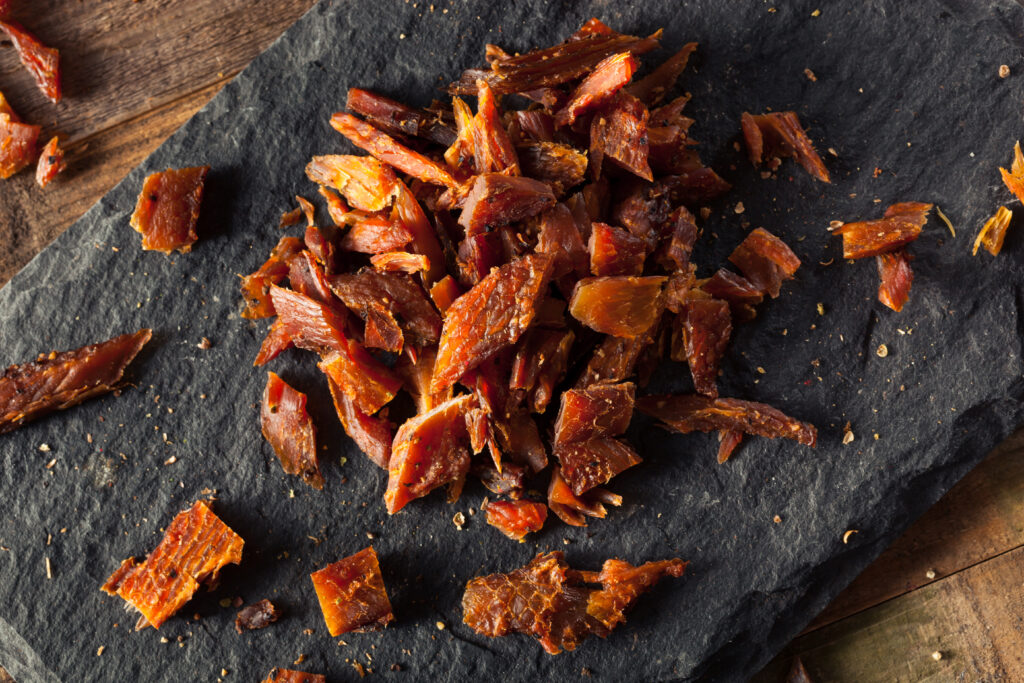
Step aside, beef jerky and vegan jerky – there’s a new star in the world of delectable dried delights. Fish jerky, a lesser-known yet remarkable culinary gem, has been making waves in gastronomic circles, and for a good reason. Combining the heartiness of traditional jerky with the unique flavors of the ocean, this exquisite snack brings a novel twist to our taste buds.
What is Fish Jerky?
At its core, fish jerky is a time-honored preservation method, dating back centuries. By curing and dehydrating fish, this process ensures a prolonged shelf life while intensifying its taste. The result is an enticing snack that retains the essence of the sea in every bite. Ranging from salmon and trout to haddock and cod, the choices are as diverse as the ocean’s inhabitants themselves.
The history and origin of fish jerky can be traced back to ancient times when various cultures found ingenious ways to preserve food for longer periods, especially in regions with limited access to refrigeration. Drying and salting were among the earliest methods employed to prevent spoilage and ensure a stable food supply. This dehydrated fish became a natural extension of this preservation tradition, and emerged as a delicious and nutritious result of this culinary ingenuity.
Origins
Native American Tribes
Native American tribes were one of the early practitioners of fish jerky. In regions near lakes, rivers, and oceans, they would sun-dry fish, creating portable and long-lasting provisions. This method allowed them to store fish for future consumption during seasons when fish were abundant and to sustain themselves during harsh winters or journeys.
Vikings and Norsemen
The seafaring Vikings and Norsemen also relied on fish jerky, or “stockfish,” as a staple of their diet during extended sea voyages. They would hang fish, particularly cod, on wooden racks to dry in the brisk sea air, preserving them for months.
Inuit and Indigenous Arctic Peoples
In the Arctic regions, where fresh food was scarce for extended periods, fish jerky became a vital source of sustenance. Indigenous peoples like the Inuit and others living in the northern latitudes utilized this jerky, along with other dried meats, to endure the challenging conditions.
Asian Influence
Fish jerky’s popularity extended to Asian countries where it became an essential part of their culinary heritage. In Japan, “himono” refers to dried fish, and “surimi” is a processed fish product often used for making jerky-like delicacies. China, Korea, and Southeast Asian countries also have their own versions of dried fish, often seasoned with local herbs and spices for added flavor.
Modern Commercialization
The concept of fish jerky gradually spread to other parts of the world, and with advancements in food preservation techniques and transportation, it became commercially available. Today, many types of jerky are sold globally, often using different fish varieties and unique seasonings to cater to diverse taste preferences.
Health and Culinary Appeal
Apart from its historical significance, fish jerky has become popular in contemporary times due to its exceptional health benefits and culinary appeal. As consumers increasingly seek nutritious and convenient snacks, this type of jerky stands out as a protein-rich, low-fat alternative to traditional meat jerky. Additionally, its unique flavors, ranging from mild to robust, attract food enthusiasts seeking new taste experiences.
The Art of Crafting Fish Jerky
Like any fine craft, creating exquisite fish jerky requires expertise and finesse. First, the fish is meticulously filleted and trimmed to remove excess fat, resulting in a lean and healthy treat. Next, a carefully balanced blend of herbs, spices, and seasonings is applied to enhance the natural flavors of the fish. The fillets then undergo a slow and gentle drying process, which perfectly preserves the essence of the sea within.
Health Benefits of Fish Jerky
Beyond its delightful taste, fish jerky offers an array of health benefits. Rich in essential nutrients like
- Omega-3 fatty acids
- high-quality protein
- phosphorous
- selenium
- vitamins D, E and B12
Additionally, it is a low-calorie option, making it an ideal choice for health-conscious snackers looking to satisfy their cravings without guilt.
Is it healthier than red meat jerky?
Yes, it is generally considered healthier than red meat jerky for several reasons:
- Lower Fat Content: Fish is naturally lower in fat compared to red meat like beef or pork. Red meat jerky typically contains higher levels of saturated fat, which can be less heart-healthy when consumed in excess.
- Omega-3 Fatty Acids: Fish is an excellent source of omega-3 fatty acids, which are essential for heart and brain health. Omega-3s are less prevalent in red meat, making fish jerky a better option for those looking to increase their intake of these beneficial fats.
- Lower Calories: Fish jerky often has fewer calories per serving than red meat jerky, making it a suitable choice for individuals watching their calorie intake.
- Cholesterol Content: Fish generally contains lower cholesterol levels than red meat. High cholesterol intake can be a concern for some individuals, and fish jerky provides a cholesterol-friendly alternative.
- Vitamins and Minerals: Fish is rich in various vitamins and minerals, such as vitamin D, vitamin B12, and selenium, which are essential for overall health. While red meat does contain some vitamins and minerals, fish tends to offer a broader range of nutrients.
- Sustainable Choice: Many fish species are considered more sustainable and environmentally friendly compared to some red meat sources, which can contribute to the depletion of natural resources and increase greenhouse gas emissions.
However, it’s essential to consider the specific type and preparation of both fish and red meat jerky. Some varieties of fish jerky may be high in sodium and added sugars, which can impact its overall healthiness. Similarly, some red meat jerky brands may opt for lean cuts of meat and minimal additives, making them a healthier option compared to certain fish jerky products.
The Flavors of the Ocean
One of the most captivating aspects of fish jerky is the range of flavors it embodies. Each variety imparts its unique taste profile, from the bold and robust smokiness of salmon jerky to the delicate brininess of haddock jerky. Moreover, the addition of various seasonings and marinades allows for endless possibilities.
Versatility at Its Finest
Fish jerky’s versatility extends far beyond being a mere snack. Its umami-rich taste can elevate various dishes, from salads and soups to pasta and rice bowls. Crushed into a savory powder, fish jerky adds depth to sauces and marinades, breathing new life into everyday cooking.
An Ethical and Sustainable Choice
As sustainability takes center stage in the culinary world, fish jerky stands proudly as an ethical choice. Sourced from well-managed fisheries and sustainable aquaculture practices, it serves as a reminder of the delicate balance we must maintain with our oceans. By savoring this jerky of the sea, you’re not just indulging in a delectable treat – you’re also supporting responsible fishing practices.
Most popular brands
- Neptune Fish Jerky: An award-winning fish jerky brand focused on fresh, sustainable, natural ingredients.
- Kaimana Jerky: Specializing in Hawaiian-inspired high-quality wild tuna jerky., Kaimana Jerky offers unique flavors and premium ingredients sourced sustainably.
- Fishpeople Seafood: This brand focuses on sustainable fishing practices and produces fish jerky made from wild-caught fish. They offer a range of flavors and products, including salmon jerky and tuna jerky.
- Epic Provisions: While primarily known for their meat-based products, Epic Provisions also offers a wild-caught salmon jerky that has gained popularity among health-conscious consumers.
- Mountain America Jerky: Offers a selection of premium handcrafted jerky made from high-quality, all-natural ingredients.
- Global Seafoods North America: A reputable supplier of high-quality seafood products, offering a diverse range of fresh and frozen seafood sourced sustainably from around the world.
How can I make it?

fish jerky
Ingredients
- 1 pound (450g) boneless, skinless fish fillets (salmon, trout, haddock, cod, or your preferred fish)
- 1/4 cup soy sauce (or tamari for a gluten-free option)
- 2 tablespoons Worcestershire sauce
- 1 tablespoon honey or maple syrup
- 1 teaspoon garlic powder
- 1 teaspoon onion powder
- 1/2 teaspoon ground black pepper
- Optional: pinch of cayenne pepper for a subtle kick
Instructions
- Rinse the fish fillets under cold water and pat them dry with paper towels. Cut the fish into thin, even strips, approximately 1/4 inch thick.
- In a medium-sized bowl, combine the soy sauce, Worcestershire sauce, honey or maple syrup, garlic powder, onion powder, black pepper, and cayenne pepper if using. Stir the marinade until all the ingredients are well mixed.
- Add the fish strips to the bowl, making sure each piece is coated with the marinade. Cover the bowl with plastic wrap and refrigerate for at least 4 hours or overnight.
- Preheat your oven to the lowest temperature setting, usually around 150°F (65°C). If using a dehydrator, follow the manufacturer's instructions for preheating.
- For oven drying, place a wire rack on top of a baking sheet to allow air circulation around the fish. If using a dehydrator, arrange the marinated fish strips on the dehydrator trays, leaving space between each piece.
- Dry the fish: For oven drying, place the baking sheet with the wire rack in the preheated oven. Prop the oven door open slightly to allow moisture to escape, ensuring the fish jerky dries evenly. For dehydrator drying, set the temperature according to the manufacturer's instructions and let it run for approximately 4 to 6 hours or until the fish jerky is fully dried.
- Check for doneness: The fish jerky is ready when it becomes dry and firm but still slightly pliable. It should not feel moist or sticky to the touch.
- Once the fish jerky is fully dried, remove it from the oven or dehydrator and let it cool to room temperature. If any moisture remains, it could lead to spoilage.
- Store the homemade fish jerky in an airtight container or resealable plastic bag. Keep it in a cool, dry place, and it should last for several weeks.
Notes
Besides eating it on its own, enjoy it as a delightful addition to salads, or a protein-packed topping for your favorite dishes!
Recommended Products
Glutto earns a tiny commission from qualifying Amazon purchases.
Did you make this recipe?
Please leave a comment on the blog or share a photo on Instagram
Fish jerky, an exquisite testament to the age-old art of food preservation, has emerged as a delightful and innovative culinary experience. With its diverse flavors, nutritional benefits, and versatility, it has earned its place among the finest gourmet snacks. So, the next time you seek an extraordinary taste adventure, let fish jerky guide you through the depths of oceanic flavors – a savory delight that honors tradition while tantalizing the contemporary palate.








